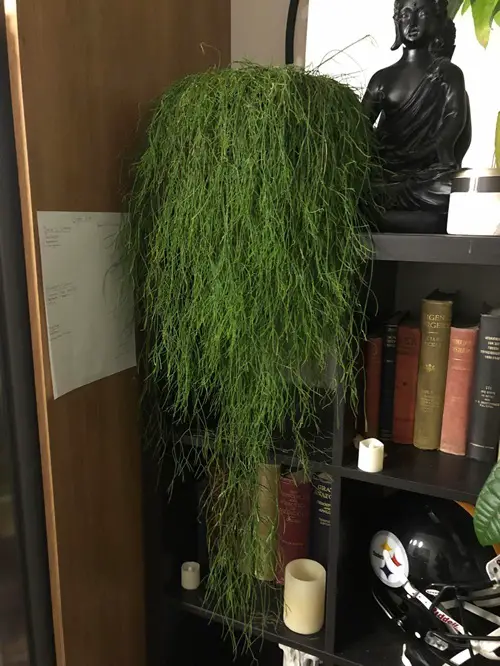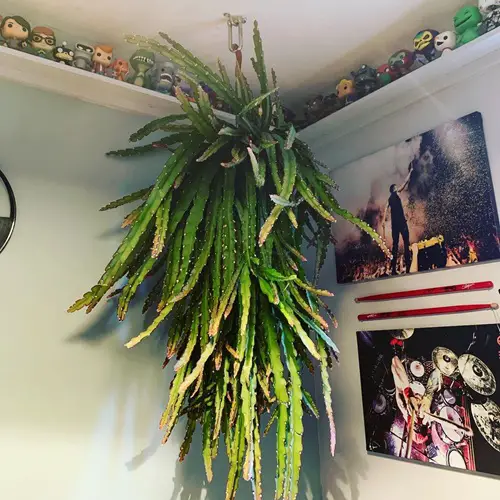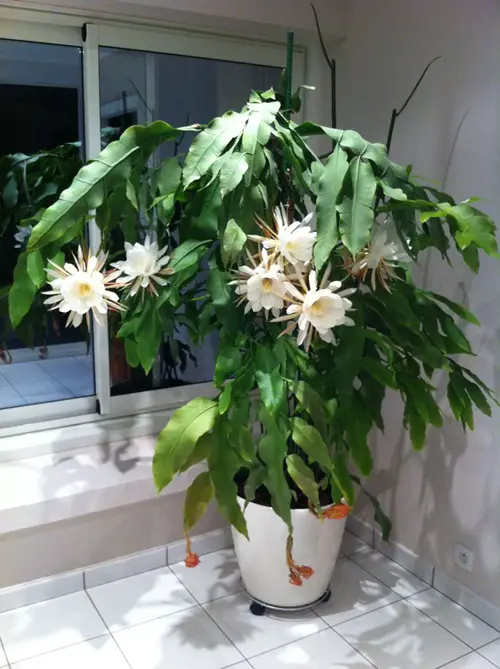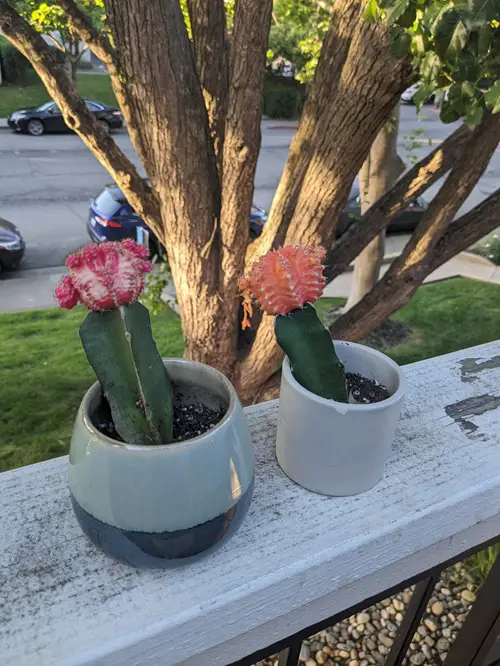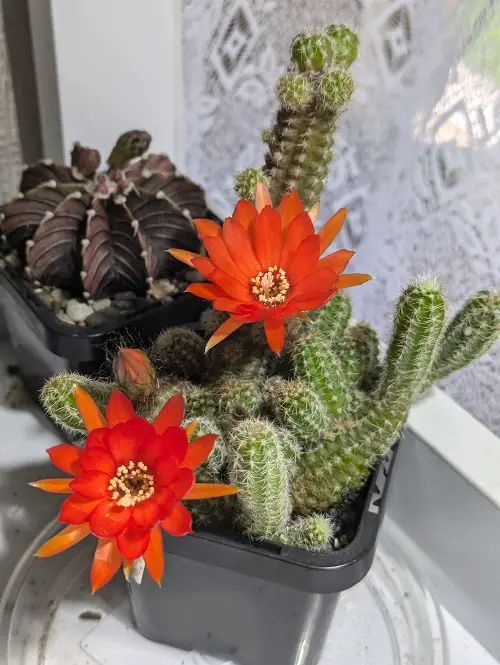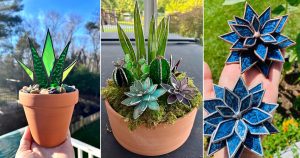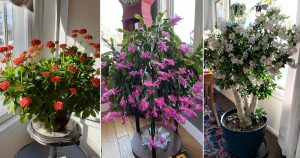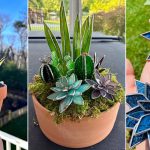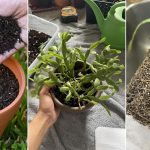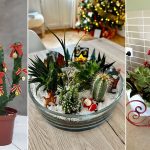Are you wondering which Cacti do well in shade? Well, here is a list of some that do great in dappled light!
When people think of cacti, they often paint the picture of sun-soaked deserts and arid landscapes. However, not all cacti are sun-loving plants! Many species love the shade or low-light environments where they thrive and bloom beautifully. Read along to learn about some of such cacti species here.
Cacti That Do Well in Shade
1. Mistletoe Cactus
Botanical name: Rhipsalis baccifera
The Rhipsalis genus includes tropical epiphytic cacti that are native to Central and South America. These plants have a unique trailing habits with pencil-thin stems and are often grown in hanging baskets. They thrive in shaded environments or under indirect sunlight, ideal for indoor growing.
Unlike desert cacti, the Mistletoe cactus prefers moist but well-draining soil and tolerates humidity levels of 60-80%. They produce small white flowers and berries, which are edible to birds.
2. Christmas Cactus
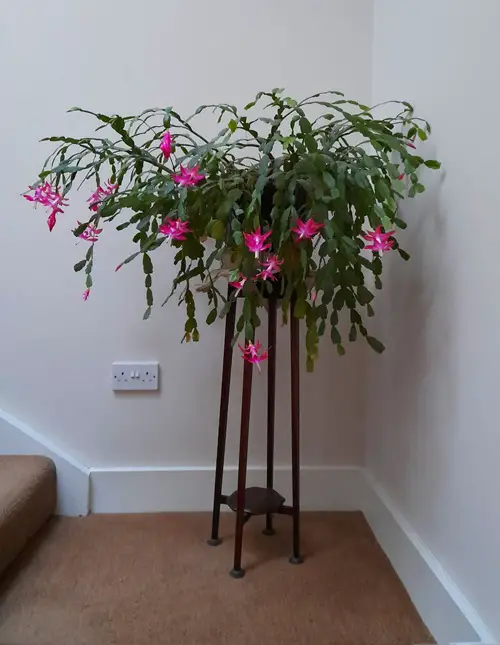
Botanical name: Schlumbergera species
The Christmas Cactus is a popular holiday plant that comes from the tropical rainforests of Brazil. It loves shady spots, does great indoors, and stays happy with evenly moist, well-drained soil.
Admired for their festive blooms that come in shades of pink, red, and white, these cacti are a favorite choice for home decor during the festive season. They thrive in 50-60% humidity and may attract pests like spider mites, mealybugs, and aphids. Root rot and fungal infections are common if overwatered, so ensure good drainage and airflow.
3. Drunkard’s Cactus
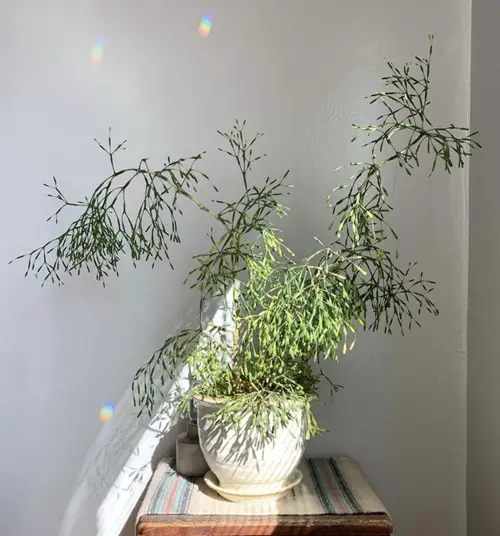
Botanical name: Hatiora salicornioides
One more from the Brazilian rainforests, the Drunkard’s Cactus is a member of the Rhipsalideae tribe. It is a shade-loving cactus known for its quirky, segmented stems resembling bottles. Yes, it’s the plant that brings its own party look! It grows well in partial to full shade with high humidity.
This cactus produces small, bell-shaped yellow flowers and thrives especially well in hanging planters. To keep it thriving the watering should be done when the soil dries and avoid direct sunlight, which can scorch its delicate stems.
4. Hurricane Cactus
Botanical name: Lepismium cruciforme
Another epiphytic cactus that flourishes in shaded areas with high humidity, the Hurricane Cactus is native to the South American rainforest region. It features flat, segmented stems and small colorful flowers.
This shade-loving cactus is one of the easiest to plant cacti varieties and it prefers regular watering and well-draining soil mixtures for optimum growth and development. It thrives in 60-75% humidity but may suffer from scale insects and fungal rot if conditions are too damp.
Fun fact: This cactus appears olive green under ideal conditions but when it is stressed shows a magenta color.
5. Queen of the Night
Botanical name: Epiphyllum oxypetalum
Queen of the Night is a tropical epiphytic spineless cactus with aerial roots and large, fragrant flowers. It requires bright and indirect light and protection from the harsh afternoon sun to produce healthy flower buds! Tree canopies are great supports for providing some dappled shade.
The spectacular flowers bloom only at night and are quite a sight to watch making a standing-out centerpiece. But be quick—these blooms are like Cinderella at the ball, gone by sunrise!
6. Chin Cactus
Botanical name: Gymnocalycium mihanovichii
Native to Paraguay and Northeast Argentina, this species is an adorable dwarf cactus that grows in rocky areas. Its globular, dark green shape makes it quite appealing and anyone will be tempted to get one of these.
Chin cacti are great for growing indoors because they prefer indirect light but bright spaces and thrive in a well-drained succulent potting mix. However, it does not tolerate humidity and prefers temperatures between 68-86 F, as it cannot withstand frost.
Note: Some varieties, like the colorful Hibotan, are commonly grafted onto other cacti because they cannot photosynthesize on their own.
7. Peanut Cactus
Botanical name: Echinopsis chamaecereus
The Peanut Cactus is a compact, clump-forming species straight from Argentina, which is why it is perfect for small spaces. Its cylindrical stems resemble peanut shells, hence it gets its cute name.
This low-maintenance cactus thrives in dappled light or partial shade and enjoys humidity levels of around 40-50%, tolerating slightly drier conditions compared to its tropical counterparts. It produces striking orange-red flowers in the spring which are just icing on the cake.
Although it’s pretty tough, keep an eye out for mealybugs and root rot. To keep it thriving, make sure the soil drains well and don’t overwater.
Shade-loving cacti prove that beauty can thrive even in the quiet corners. They’re like introverts at a party, quietly stealing the show without needing the limelight. Try to add these adaptable plants to your collection and enjoy their charm and resilience in any light!

